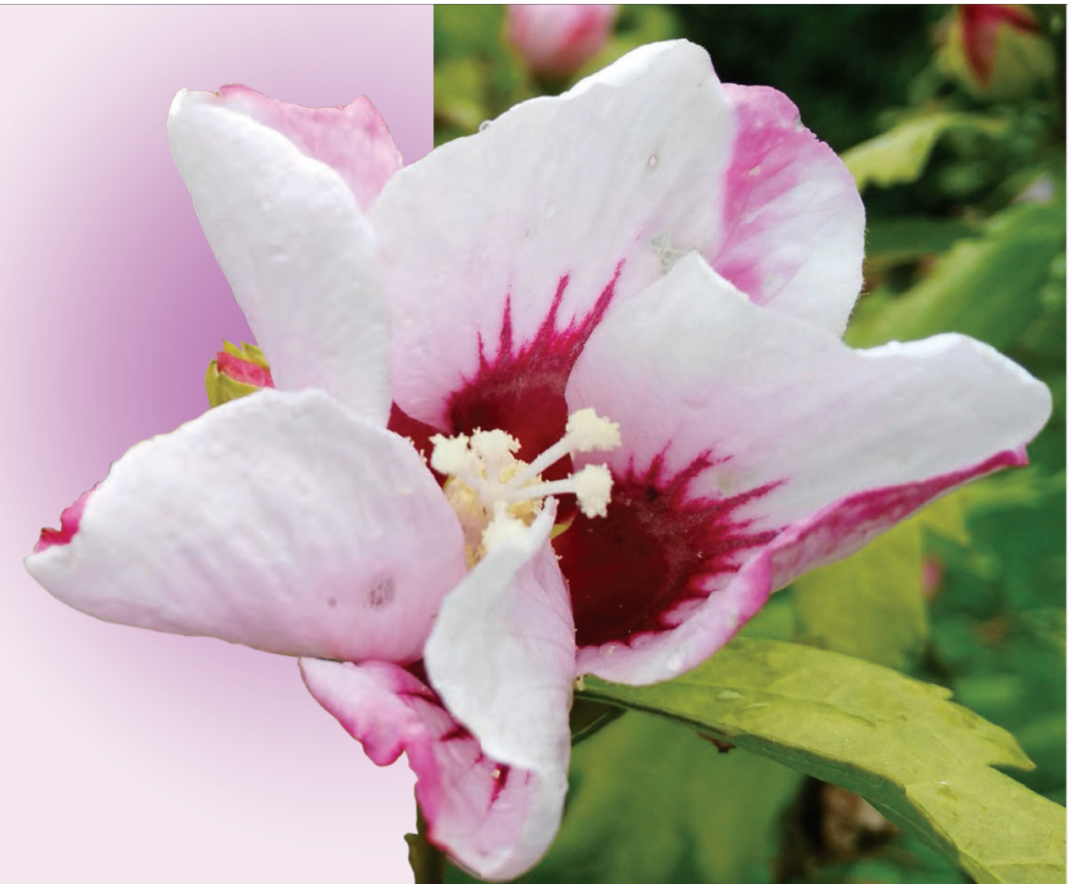Paul Fitters reports on the results of a three-year Euro- trial that compared 56 Hibiscus syriacus cultivars for general performance

From 2016 to 2018, 56 Hibiscus syriacus cultivars were compared for general performance at Pat Fitzgerald’s nursery in Co. Kilkenny. The same cultivars were tested in several European countries as part of the Euro-trials.
The Euro-trial group consists of participants from Austria, Belgium, The Netherlands, France, Germany, England, Finland, Ireland and recently also Iceland. The aim of this group is to test cultivars of a particular plant species under different climatic regimes. The same cultivars are tested in all countries. This research is similar to the Royal Horticultural Society (RHS) Award of Garden Merit (AGM) trials in the UK, but with a broader climatic range. Plant species tested so far are Weigela, Vinca, Hydrangea and Buddleia. Currently, Physocarpus and Spiraea trials are on-going and the Hibiscus trial is just finished and reported on in this article.
SET UP AND ASSESSMENTS
The grafted Hibiscus syriacus cultivars were provided by Minier Nursery in France and arrived in each country in the autumn of 2014. In Ireland, they were planted (56 cultivars * 3 replicate plants each) at Pat Fitzgerald’s nursery in Co. Kilkenny. After establishment, the plants were assessed for three years on general shape and health, but mainly on flower power (quality, abundance and period of flowering). Plants were marked between 0 and 10 for each category by a panel of assessors from the industry, WIT/Teagasc college lecturers and students.
RESULTS
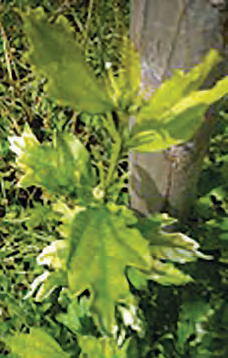

In Ireland, the plants came into leaf very late (May) and early leaves were often yellow with white margins (see photo). The white margins stayed on these leaves but disappeared out of sight with new leaves appearing.
There were no general health issues with the plants. The plants were never sprayed. Aphids and leaf spots did appear on some plants but were never a real problem. The same could be said about die-back of twigs which was found in some cultivars in year one, but to a limited extent, and plants quickly grew out of it. As a result, the combined mark for general health and shape is mainly a mark about the shape of the plant. Some plants were more upright than others while others were more spreading inhabit. There were also differences in compactness.
There was a big difference in flowering quality between the cultivars, as well as in abundance and weeks of continued flowering. Flowering also varied per year of assessment with some cultivars doing well one year and not another. Some variation could also be attributed to the actual day of the assessment, as a cold or wet week had a big impact on the flower quality. The mark shown in Table 1 is a three-year average.


The flowering period varied from 0 to 7 weeks. All plants produced flower buds, but some failed to properly open (on assessment days) and early on in the season some cultivars dropped their buds. Cold and wet weather (summer 2017) meant that the flowers did not always open and often got spoiled by the wet. Colder nights the day before opening also inhibits opening even if it is sunny the next day. This could account for the reduced performance in Ireland compared to some European countries such as France and Austria where Hibiscus can flower well from June until October. Despite this, some interesting cultivars have been identified that even look good when in bud, such as ‘Mindour’ (French Cabaret Red). Other cultivars tolerate wet weather better and flowered well, such as ‘Minspot’ (Pinky Spot).
The 12 best performing cultivars, with each colour (white, pink, blue and red) included, are given in Table 1.
The overall best performing H. syriacus cultivar was ‘Minspot’ (Pinky Spot) PBR. It had a long flowering period of over seven weeks, and overall the highest score for both flower
quality and plant shape and performed consistently well in all three assessment years.
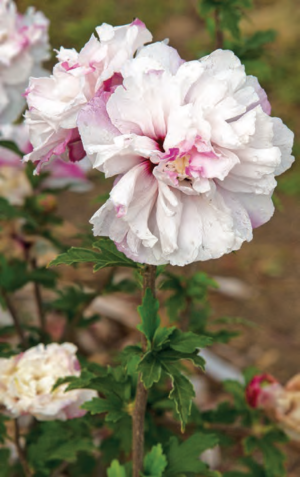

H. syriacus ‘Minspot‘(Pinky Spot) has simple white flowers with a red heart and white stamens. Second best of the white with red heart cultivars was the semidouble flower H. syriacus ‘Mindoub1’ PBR (French Cabaret Pastel). Other good performing cultivars were ‘Mathilde’, ‘Melrose’ and ‘Leopoldii’ the latter has double flowers which look good even in
bud, but flowers sometimes fail to open fully).
H. syriacus ‘Mindour1’ PBR (French Cabaret Red) came out as best red/maroon flowering cultivar. It has double flowers that often failed to open properly under the Irish weather, but as a result, had a long-lasting effect. H. syriacus ‘Duc de Brabant’ PBR came out second best of the red flowering cultivars.
H. syriacus ‘Notwood two’ PBR/AGM (White Chiffon) came out as best white flowering cultivar. It is a semi-double.
H. syriacus ‘Eléonore’ PBR came out as second best white flowering cultivar. The flowering lasted about six to seven weeks and their growth was moderate. Another good white cultivar was H. syriacus ‘William R. Smith’ AGM, a single white long flowering cultivar
| Hibiscus syriacus cv. (+ selling name) | Colour | Flower quality and abundance | Flowering period (weeks) | Health and shape |
| ‘Minspot‘ (Pinky Spot) | Best overall white/pink | 6.8 | 7 | 6.6 |
| ‘Mindoub1’ (French Cabaret Pastel) | white/pink | 5.7 | 3 | 6.2 |
| ‘Mathilde’ | white/pink | 4.8 | 6 | 5.5 |
| ‘Melrose’ | white/pink | 4.3 | 5 | 5.4 |
| ‘Leopoldii’ | white pink semi-double | 5.4 | 0* | 5.8 |
| ‘Mindour1’ (French Cabaret Red) | Best red double | 5.2 | 3 | 6.5 |
| ‘Duc de Brabant’ | red | 5.3 | 0* | 6.0 |
| ‘Notwoodtwo’ (White Chiffon | Best white | 5.2 | 3 | 5.8 |
| ‘Eléonore’ | white | 4.5 | 6 | 4.7 |
| ‘William R. Smith’ | white | 4.1 | 7 | 3.9 |
| ‘Minultra’ (Ultramarine) | Best blue | 4.5 | 5 | 4.6 |
| ‘Notwood3’ (Blue Chiffon) | blue | 3.5 | 4 | 4.2 |
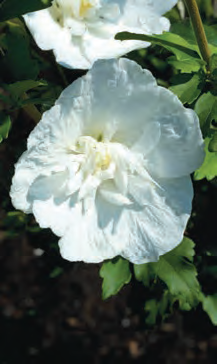

The blue flowering cultivars, in general, did not score as well as the white or pink flowering ones. Of the six cultivars tested, H. syriacus ‘Minultra’ (Ultramarine) PBR came out as the best blue flowering cultivar. The flowering period for all six blue cultivars was about five weeks and their growth was moderate. Second best of the blue cultivars was the semi-double H. syriacus ‘Notwood3’ (Blue Chiffon) PBR/AGM. There was not much difference between the six blue flowering cultivars.
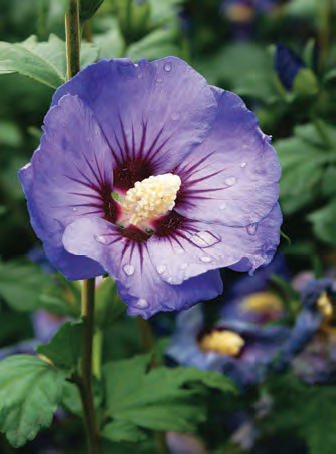

In hindsight, the site chosen for the Hibiscus trial was not ideal as it was exposed and hence at times windy and cold. Hibiscus likes a sheltered and warm site to do well. On the other hand, all cultivars were exposed to the same, sometimes challenging conditions, so a comparison could be made and a selection of the best suited for general Irish conditions could be made. If the same cultivars were grown in a more sheltered and warmer spot (e.g. in city gardens), they are likely to do better. The top 12 cultivars are grown on in the Teagasc, Ashtown campus to assess just that.
The performance of the Hibiscus cultivars in Ireland was not as impressive as their performance says in Belgium or Austria, and this is reflected in a lower overall marking. In Table 2 you can find a list of all the cultivars tested and the rating they got in five other countries. In this table, the rating is reduced to a star system (0 to 3 stars) for easier comparison. It shows the value of Eurotrials as different cultivars perform well in each country. There is even a difference between Ireland and the UK, despite having a comparable climate.
| Final results | Austria | Belgium | Germany | Ireland | Netherlands | UK |
| Rating | Rating | Rating | Rating | Rating | Rating | |
| Admiral Dewey | ** | ** | * | 0 | 0 | |
| America Irène Scott (Sugar Tip) | *-** | *** | 0 | 0 | * | 0 |
| Aphrodite | 0 | 0 | 0 | 0 | 0 | ** |
| Ardens | *-** | * | * | 0 | 0 | * |
| Boule de Feu | 0 | ** | * | 0 | 0 | 0 |
| Bricutts (China Chiffon) | *** | 0 | *** | * | 0 | ** |
| Britreize (Kimono) | * | 0 | * | ** | 0 | ** |
| Coelestris | ** | 0 | ** | 0 | 0 | ** |
| Collie Mullens | * | ** | * | 0 | * | 0 |
| Diana | ** | 0 | ** | 0 | * | ** |
| Duc de Brabant | * | ** | ** | ** | 0 | 0 |
| DVPazurri (Azurri) | * | ** | ** | 0 | ** | ** |
| Eleonore | ** | 0 | * | ** | *** | ** |
| Flogi (Pink Giant) | *-** | ** | ** | 0 | * | * |
| Floru (Russian Violet) | *-** | * | ** | 0 | 0 | ** |
| Freedom | ** | 0 | * | 0 | * | * |
| Gandini Santiago (Purple Pillar | ** | 0 | * | 0 | s | 0 |
| Hamabo | * | * | ** | 0 | 0 | ** |
| Helene | * | *** | ** | ** | * | ** |
| Jeanne d’Arc | ** | *** | * | 0 | 0 | * |
| Jwnwood4 (Pink Chiffon | ** | 0 | *** | 0 | *** | ** |
| Kakapo | ** | 0 | 0 | 0 | 0 | |
| Lady Stanley | ** | 0 | ** | 0 | ** | * |
| Lenny | * | 0 | * | 0 | 0 | * |
| Leopoldii | * | 0 | * | ** | 0 | 0 |
| Maike | ** | 0 | ** | * | 0 | * |
| Marina | ** | ** | * | 0 | * | *** |
| Mathilde | * | 0 | * | ** | 0 | ** |
| Mauve Queen | * | * | * | 0 | * | * |
| Meehanii | 0 | 0 | s | 0 | s | ** |
| Melrose | ** | 0 | * | * | * | *** |
| Melwhite | ** | 0 | 0 | 0 | 0 | * |
| Mindoub1 (French Cabaret Pastel) | * | *** | * | * | 0 | * |
| Mindour1 (French Cabaret Red) | * | ** | * | ** | * | ** |
| Mindouv5 (French Cabaret Purple) | ** | 0 | *** | ** | ** | * |
| Mineru (Eruption) | * | 0 | ** | 0 | *** | ** |
| Minfren (French Point) | ** | * | ** | * | * | * |
| Mingravi4 (B’twist Lavender) | *** | 0 | *** | * | ** | *** |
| Minomb (Sup’heart) | *** | * | ** | 0 | ** | *** |
| Minpast (Pastelrose) | * | 0 | * | 0 | 0 | * |
| Minrosa (Rosalbane) | ** | 0 | * | 0 | * | * |
| Minspot (Pinky Spot) | *** | 0 | *** | *** | ** | *** |
| Minultra (Ultramarine) | * | * | ** | * | 0 | *** |
| Notwood3 (Blue Chiffon) | * | ** | *** | 0 | * | *** |
| Notwoodone (Lavender Chiffon) | ** | 0 | *** | 0 | *** | *** |
| Notwoodtwo (White Chiffon) | *** | 0 | *** | * | ** | *** |
| Oiseau Bleu | ** | 0 | ** | 0 | 0 | ** |
| Puniceus Plenus | * | 0 | * | 0 | 0 | 0 |
| Red Heart | * | * | ** | 0 | 0 | *** |
| Rubis | 0 | 0 | * | 0 | 0 | 0 |
| Sanchonyo (Purple Ruffles) | ** | ** | ** | 0 | * | * |
| Snowdrif | ** | 0 | * | 0 | * | |
| Speciosus | ** | *** | ** | 0 | ** | ** |
| Stadt Erlenbach | * | ** | * | 0 | 0 | 0 |
| William R. Smith | * | 0 | ** | ** | 0 | ** |
| Woodbridge | 0 | 0 | ** | 0 | *** | ** |
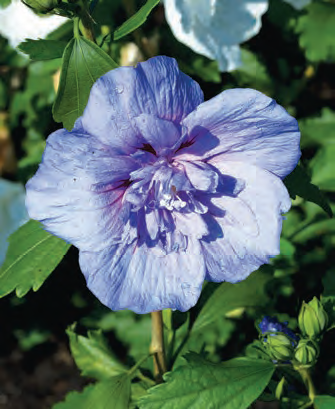

CONCLUSION
Despite not doing as well in Ireland compared to other countries with warmer summers, the above-mentioned plants in Table 1 did well and could be very useful garden plants in sheltered locations.
I would like to thank Minier nursery for proving the grafted Hibiscus cultivars, Pat Fitzgerald for providing the space in his nursery to do this trial, Bord Bia for paying the Eurotrial membership fee, Teagasc for providing me with time and resources to organise the trial and finally all the assessors for giving up their time to assess the cultivars so professionally. ✽
  |



